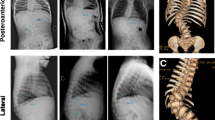Abstract
Study Design
IRB-approved retrospective single cohort study.
Objectives
To review our ten-year history with EDF (Elongation Derotation Flexion) casting in patients with infantile idiopathic scoliosis (IIS) to better understand which factors predict successful outcomes.
Summary of Background Data
Numerous studies have demonstrated the efficacy of EDF casting in the treatment of progressive infantile idiopathic scoliosis. But none have reproduced the success of Mehta’s even with early intervention.
Methods
Patients with IIS treated with EDF casting with a minimum 24-month follow-up were included. Radiographs and clinical records were reviewed. Age, sex, and curve type were documented. Precast, traction, in cast, in brace, and final Cobb angles were measured and recorded. Outcomes were defined by Cobb angle at final follow-up out of cast or brace. Patients were considered cured if the final Cobb angle was <10°, palliated at 10°–45°, and failed if they required surgical treatment.
Results
Sixty-three patients with IIS were reviewed. Thirty-two were excluded for incomplete records or insufficient follow-up, leaving 31 patients. No patients progressed to surgical intervention during the study. Patients with a Cobb angle >10° in the final cast were 7.3 times more likely to fall into the palliative range at the most recent follow-up than if their Cobb angle was 10° or less even when adjusted for age. Earlier age at onset of casting (14.9 vs. 21.1 months) was not statistically significant (p=.073). Magnitude of initial curvature, flexibility, initial correction, sex, and curve type were also not found to be significant.
Conclusion
EDF casting is a valid treatment option for IIS with a high cure rate. Major Cobb angle at the end of casting is most predictive of outcome. Cobb angles >10° at the end of casting had a 7.3 times greater risk of falling into the palliated category versus Cobb angles less than or equal to 10° even when adjusted for age. Initial curve magnitude, curve flexibility, sex, and curve type were not predictive.
Level of Evidence
Level IV.
Similar content being viewed by others
References
Williams BA, Matsumoto H, McCalla DJ, et al. Development and initial validation of the Classification of Early-Onset Scoliosis (CEOS). J Bone Joint Surg Am 2014;96:1359–67.
Scott JC, Morgan TH. The natural history and prognosis of infantile idiopathic scoliosis. J Bone Joint Surg Br 1955;37:400–13.
Ceballos T, Ferrer-Torrelles M, Castillo F, Fernandez-Paredes E. Prognosis in infantile idiopathic scoliosis. J Bone Joint Surg Am 1980;62:863–75.
Thompson SK, Bentley G. Prognosis in infantile idiopathic scoliosis. J Bone Joint Surg Br 1980;62:151–4.
McMaster MJ. Infantile idiopathic scoliosis: can it be prevented? J Bone Joint Surg Br 1983;65:612–7.
Ferreira JH, de Janeiro R, James JI. Progressive and resolving infantile idiopathic scoliosis. The differential diagnosis. J Bone Joint Surg Br 1972;54:648–55.
Lloyd-Roberts GC, Pilcher MF. Structural idiopathic scoliosis in infancy: a study of the natural history of 100 patients. J Bone Joint Surg Br 1965;47:520–3.
Mehta MH. Growth as a corrective force in the early treatment of progressive infantile scoliosis. J Bone Joint Surg Br 2005;87:1237–47.
Pehrsson K, Larsson S, Oden A, Nachemson A. Long-term follow-up of patients with untreated scoliosis. A study of mortality, causes of death, and symptoms. Spine (Phila Pa 1976) 1992;17:1091–6.
Waldhausen JH, Redding GJ, Song KM. Vertical expandable prosthetic titanium rib for thoracic insufficiency syndrome: a new method to treat an old problem. J Pediatr Surg 2007;42:76–80.
Karol LA, Johnston C, Mladenov K, et al. Pulmonary function following early thoracic fusion in non-neuromuscular scoliosis. J Bone Joint Surg Am 2008;90:1272–81.
Sankar WN, Skaggs DL, Yazici M, et al. Lengthening of dual growing rods and the law of diminishing returns. Spine (Phila Pa 1976) 2011;36:806–9.
Smith JR, Samdani AF, Pahys J, et al. The role of bracing, casting, and vertical expandable prosthetic titanium rib for the treatment of infantile idiopathic scoliosis: a single-institution experience with 31 consecutive patients. Clinical article. J Neurosurg Spine 2009;11: 3–8.
Bess S, Akbarnia BA, Thompson GH, et al. Complications of growing-rod treatment for early-onset scoliosis: analysis of one hundred and forty patients. J Bone Joint Surg Am 2010;92:2533–43.
Goldberg CJ, Gillic I, Connaughton O, et al. Respiratory function and cosmesis at maturity in infantile-onset scoliosis. Spine (Phila Pa 1976) 2003;28:2397–406.
Choi E, Yazsay B, Mundis G, et al. Implant complications after magnetically controlled growing rods for early onset scoliosis: a multicenter retrospective review. J Pediatr Orthop 2017;37: e588–92.
Baulesh DM, Huh J, Judkins T, et al. The role of serial casting in early-onset scoliosis (EOS). J Pediatr Orthop 2012;32:658–63.
Dhawale AA, Shah SA, Reichard S, et al. Casting for infantile scoliosis: the pitfall of increased peak inspiratory pressure. J Pediatr Orthop 2013;33:63–7.
Hassanzadeh H, Nandyala SV, Puvanesarajah V, et al. Serial Mehta cast utilization in infantile idiopathic scoliosis: evaluation of radiographic predictors. J Pediatr Orthop 2017;37:387–91.
Iorio J, Orlando G, Diefenbach C, et al. Serial casting for infantile idiopathic scoliosis: radiographic outcomes and factors associated with response to treatment. J Pediatr Orthop 2017;37:311–6.
Sanders JO, D’Astous J, Fitzgerald M, et al. Derotational casting for progressive infantile scoliosis. J Pediatr Orthop 2009;29:581–7.
Waldron SR, Poe-Kochert C, Son-Hing JP, Thompson GH. Early onset scoliosis: the value of serial risser casts. J Pediatr Orthop 2013;33:775–80.
Demirkiran HG, Bekmez S, Celilov R, et al. Serial derotational casting in congenital scoliosis as a time-buying strategy. J Pediatr Orthop 2015;35:43–9.
Castro Jr FP. Adolescent idiopathic scoliosis, bracing, and the Hueter-Volkmann principle. Spine J 2003;3:180–5.
Author information
Authors and Affiliations
Corresponding author
Additional information
Author disclosures: MCW (none), JD (none), SB (none), JH (consultant for Globus Medical).
Rights and permissions
About this article
Cite this article
Welborn, M.C., D’Astous, J., Bratton, S. et al. Infantile Idiopathic Scoliosis: Factors Affecting EDF Casting Success. Spine Deform 6, 614–620 (2018). https://doi.org/10.1016/j.jspd.2018.01.007
Received:
Revised:
Accepted:
Published:
Issue Date:
DOI: https://doi.org/10.1016/j.jspd.2018.01.007




